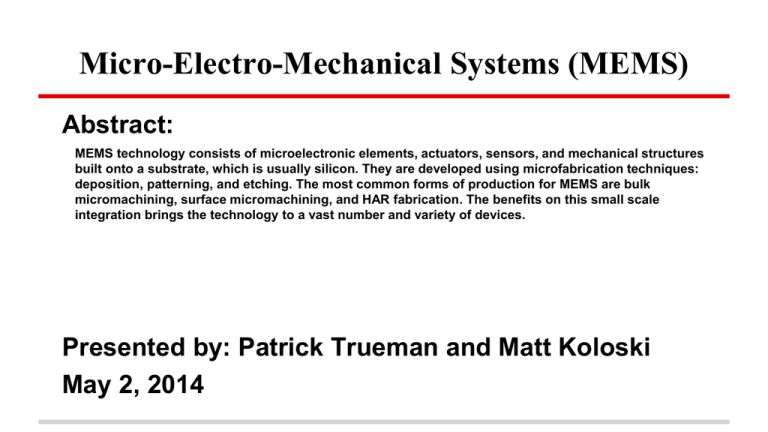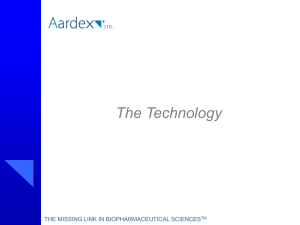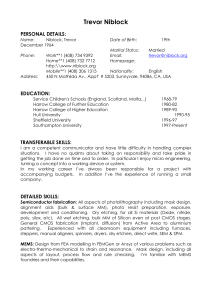Micro-Electro-Mechanical Systems (MEMS)
advertisement

Micro-Electro-Mechanical Systems (MEMS) Abstract: MEMS technology consists of microelectronic elements, actuators, sensors, and mechanical structures built onto a substrate, which is usually silicon. They are developed using microfabrication techniques: deposition, patterning, and etching. The most common forms of production for MEMS are bulk micromachining, surface micromachining, and HAR fabrication. The benefits on this small scale integration brings the technology to a vast number and variety of devices. Presented by: Patrick Trueman and Matt Koloski May 2, 2014 Introduction/Outline - What Are MEMS? Components of MEMS Fabrication MEMS Operation Applications Summary 5 Key Concepts ?Questions? What are MEMS? • Made up of components between 1-100 micrometers in size • Devices vary from below one micron up to several mm • • Functional elements of MEMS are miniaturized structures, sensors, actuators, and microelectronics One main criterion of MEMS is that there are at least some elements that have mechanical functionality, whether or not they can move Components Microelectronics: • • “brain” that receives, processes, and makes decisions data comes from microsensors Microsensors: • • • constantly gather data from environment pass data to microelectronics for processing can monitor mechanical, thermal, biological, chemical readings Microactuator: • • acts as trigger to activate external device microelectronics will tell microactuator to activate device Microstructures: • • extremely small structures built onto surface of chip built right into silicon of MEMS optical, and magnetic Fabrication Processes Deposition: • • • deposit thin film of material (mask) anywhere between a few nm to 100 micrometers onto substrate physical: material placed onto substrate, techniques include sputtering and evaporation chemical: stream of source gas reacts on substrate to grow product, techniques include chemical vapor deposition and atomic layer deposition • substrates: silicon, glass, quartz • thin films:polysilicon, silicon dioxide, silicon nitride, metals, polymers Patterning: • • transfer of a pattern into a material after deposition in order to prepare for etching techniques include some type of lithography, photolithography is common Etching: • • • • wet etching: dipping substrate into chemical solution that selectively removes material process provides good selectivity, etching rate of target material higher that mask material dry etching: material sputtered or dissolved from substrate with plasma or gas variations choosing a method: desired shapes, etch depth and uniformity, surface roughness, process compatibility, safety, cost, availability, environmental impact Fabrication Methods Bulk Micromachining: • • • • • • oldest micromachining technology technique involves selective removal of substrate to produce mechanical components accomplished by physical or chemical process with chemical being used more for MEMS production chemical wet etching is popular because of high etch rate and selectivity isotropic wet etching: etch rate not dependent on crystallographic orientation of substrate and etching moves at equal rates in all directions anisotropic wet etching: etch rate is dependent on crystallographic orientation of substrate Surface Micromachining: • • • • • • • process starts with deposition of thin-film that acts as a temporary mechanical layer (sacrificial layer) device layers are constructed on top deposition and patterning of structural layer removal of temporary layer to allow movement of structural layer benefits: variety of structure, sacrificial and etchant combinations, uses single-sided wafer processing allows higher integration density and lower resultant per die cost compared to bulk micromachining disadvantages: mechanical properties of most thin-films are usually unknown and reproducibility of their mechanical properties Wafer Bonding: • • • Method that involves joining two or more wafers together to create a wafer stack Three types of wafer bonding: direct bonding, anodic bonding, and intermediate layer bonding All require substrates that are flat, smooth, and clean in order to be efficient and successful High Aspect Ratio Fabrication (Silicon): • • Deep reactive ion etching (DRIE) • • Sidewalls of the etched holes are nearly vertical Enables very high aspect ratio etches to be performed into silicon substrates Depth of the etch can be hundreds or even thousands of microns into the silicon substrate. Benefits/Tradeoffs • • • • • Much smaller area Cheaper than alternatives ○ In medical market, that means disposable Can be integrated with electronics (system on one chip) Speed: ○ Lower thermal time constant ○ Rapid response times(high frequency) Power consumption: ○ low actuation energy ○ low heating power • Imperfect fabrication techniques • Difficult to design on micro scales Where Are MEMS? Smartphones, tablets, cameras, gaming devices, and many other electronics have MEMS technology inside of them http://www.chipworks.com/en/technical-competitive-analysis/resources/blog/inside-the-samsung-galaxy-s5/ MEMS Operation • • Sensors & Actuators • Additionally: Microfluidic 3 main types of transducers: o Capacitive o Piezoelectric o Thermal Inertial Sensors MEMS Accelerometer MEMS Gyroscope Biomedical Applications ● Usually in the form of pressure sensors ○ Intracranial pressure sensors ○ Pacemaker applications ○ Implanted coronary pressure measurements ○ Intraocular pressure monitors ○ Cerebrospinal fluid pressure sensors ○ Endoscope pressure sensors ○ Infusion pump sensors ● Retinal prosthesis ● Glucose monitoring & insulin delivery ● MEMS tweezers & surgical tools ● Cell, antibody, DNA, RNA enzyme measurement devices Blood Pressure sensor on the head of a pin In the Car Additional Applications • Optical MEMS o • Ex: optical switches, digital micromirror devices (DMD), bistable mirrors, laser scanners, optical shutters, and dynamic micromirror displays RF MEMS o Smaller, cheaper, better way to manipulate RF signals o Reliability is issue, but getting there Summary/Conclusion Micro-Electro-Mechanical Systems are 1-100 micrometer devices that convert electrical energy to mechanical energy and vice-versa. The three basic steps to MEMS fabrication are deposition, patterning, and etching. Due to their small size, they can exhibit certain characteristics that their macro equivalents can’t. MEMS produce benefits in speed, complexity, power consumption, device area, and system integration. These benefits make MEMS a great choice for devices in numerous fields. References • • • • • • "What Is MEMS Technology?" What Is MEMS Technology? N.p., n.d. Web. 28 Apr. 2014. "Fabricating MEMS and Nanotechnology." Fabricating MEMS and Nanotechnology. N.p., n.d. Web. 28Apr. 2014. D. J. Nagel and M. E. Zaghloul,“MEMS: Micro Technology, MegaImpact,” IEEE Circuits Devices Mag.,pp. 14-25, Mar. 2001. K. W. Markus and K. J. Gabriel,“MEMS: The Systems Function Revolution,” IEEE Computer, pp. 25-31, Oct. 1990. K. W. Markus, “Developing Infrastructure to Mass-Produce MEMS,” IEEE Comput. Sci. Eng., Mag., pp. 49-54, Jan. 1997. M. E. Motamedi, "Merging Micro-optics with Micromechanics: Micro-Opto-Electro-Mechanical (MOEM) devices", Critical Reviews of Optical Science and Technology, V. CR49, SPIE Annual Meeting, Proceeding of Diffractive and Miniaturized Optics, page 302-328, July, 1993 http://seor.gmu.edu/student_project/syst101_00b/team07/components.html https://www.mems-exchange.org/MEMS/fabrication.html http://www-bsac.eecs.berkeley.edu/projects/ee245/Lectures/lecturepdfs/Lecture2.BulkMicromachining.pdf • • • Images • • • • • • http://www.docstoc.com/docs/83516847/What-are-MEMS http://seor.gmu.edu/student_project/syst101_00b/team07/images/MEMScomponents2.gif http://www.empf.org/empfasis/2010/December10/images/fig3-1.gif http://pubs.rsc.org/en/content/articlehtml/2003/AN/B208563C#sect274 http://www.photonics.com/images/Web/Articles/2008/11/1/thumbnail_35519.jpg https://www.memsnet.org/mems/fabrication.html 5 Key Concepts 1. MEMS are made up of microelectronics, microactuators, microsensors, and microstructures. 2. The three basic steps to MEMS fabrication are: deposition, patterning, and etching. 3. Chemical wet etching is popular because of high etch rate and selectivity. 4. 3 types of MEMS transducers are: capacitive, thermal, and piezoelectric. 5. The benefits of using MEMS: speed, power consumption, size, system integration(all on one chip).



